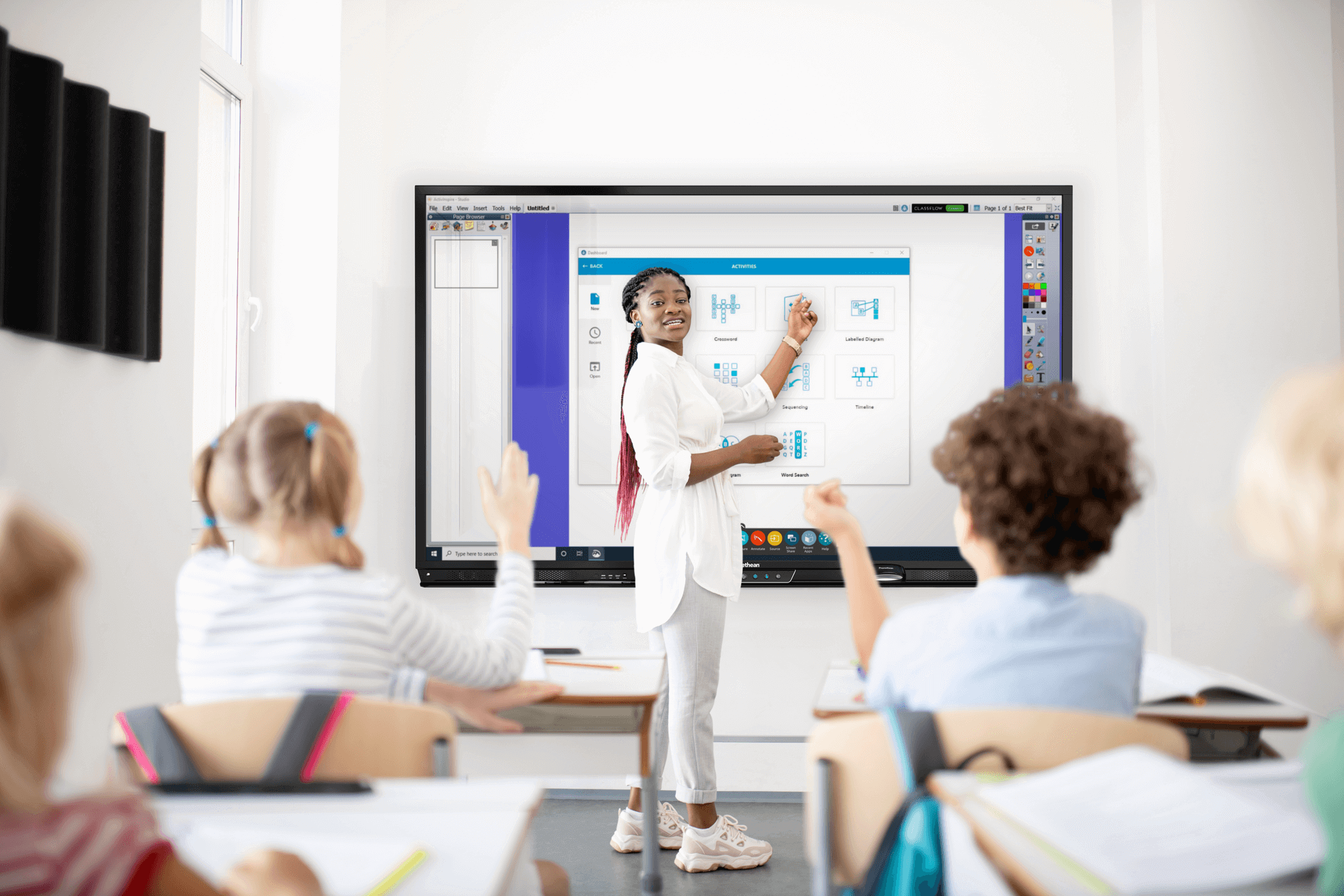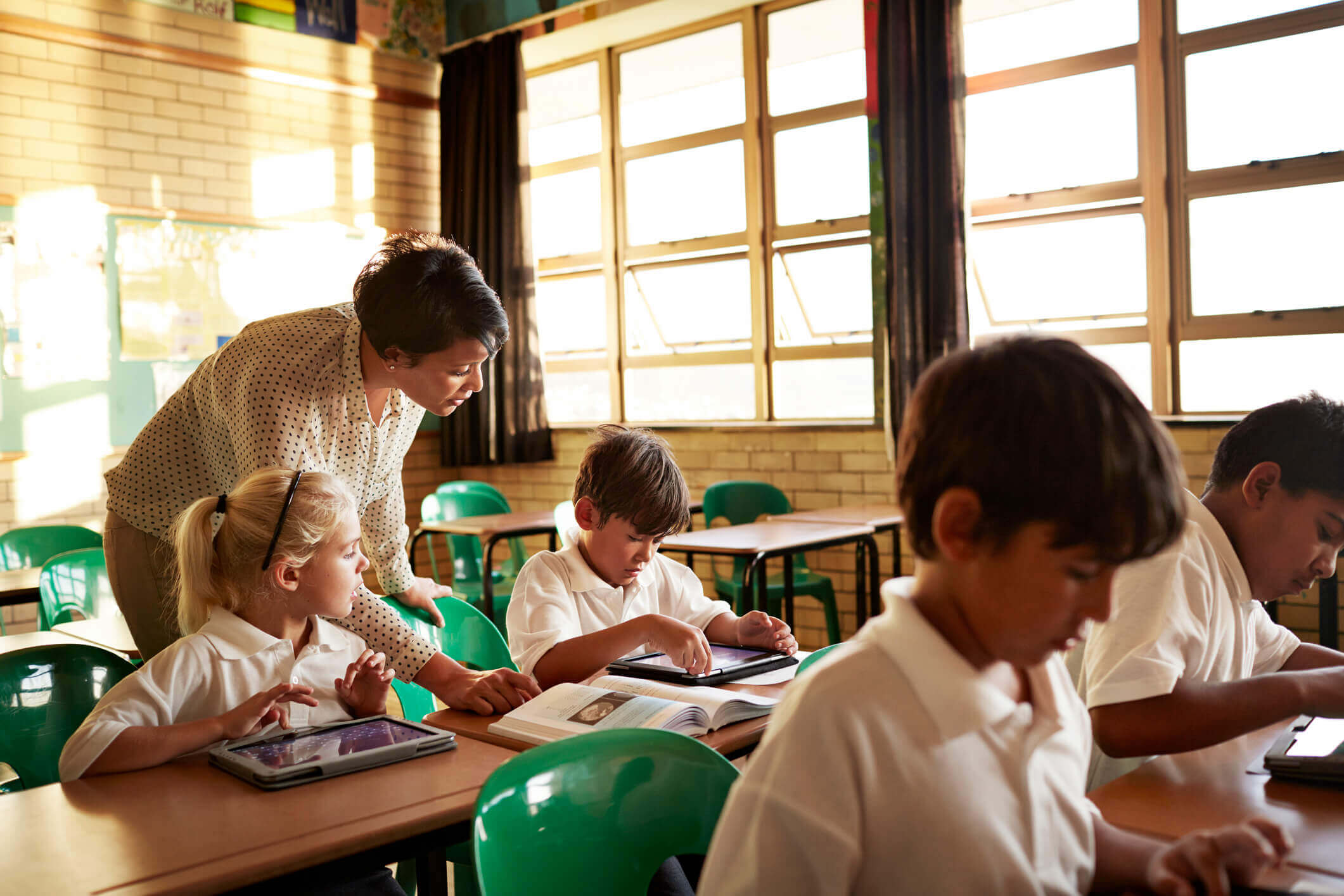Published on March 9th, 2022
The classroom guide to interactive whiteboards
15 minute read

An interactive whiteboard is this generation’s take on traditional whiteboards. Also known as digital whiteboards or smart whiteboards, these interactive displays are used in various classroom and educational settings to increase productivity, interaction, and collaboration.
With advancements in educational technology (edtech), there have been significant changes in what interactive whiteboards can do, so we’re going to help you understand everything you need to know about interactive whiteboards in the classroom.
What is an interactive whiteboard?
So what actually is an interactive whiteboard? Interactive whiteboards, or smart panels to many, come in a couple of different guises. Historically, they were a whiteboard that still used a projector that allowed you to interact with things on the screen, using pens and touch to highlight or change what was being projected.
In more recent years, interactive whiteboards have changed again, continuing to update with the times. Now, an interactive whiteboard is more akin to a display with even more intuitive interactive elements. This means that rather than use a projector, you’ll find many interactive whiteboards are simply smart screens that can connect to the internet, play video, show presentations and even connect to other devices in your classroom.
Digital whiteboards make a teacher’s life easier
Digital whiteboards allow teachers to interact directly with displays and presentations through touch interfaces.
The smart whiteboards usually come in two options: standalone and connected. Standalones allow users to rely solely on the digital whiteboard, a computer and an interactive interface. The latter requires users to connect their interactive whiteboards to computers. In this case, digital whiteboards are similar to touchpads but provide audiences with a much larger and more vivid view of the content.
Key features of an interactive whiteboard
Mobility
Digital whiteboards can be mounted onto a wall or on a mobile stand, allowing them to transition between classrooms seamlessly.
Collaboration
One significant benefit of a digital whiteboard is increased engagement with displays and presentations, made possible by a user’s ability to interact with the interactive display, which leads to better focus and material retention. The next key feature of interactive whiteboards is what makes this so simple.
Connectivity
Digital whiteboards allow students to connect to the board itself, giving them the chance to become active participants in lessons. This connectivity creates the opportunity for real-time collaborative editing, polling, formatting and so much more.
Advantages of interactive whiteboards & displays
The days of a projected presentation blacked out by a pacing presenter are long gone. Digital whiteboards put the presentation and display in the hands of the teacher, instructor, or presenter without sacrificing audience engagement. Now you can present all sorts of things, not just static drawings. You’ll be able to enhance lessons with multimedia and interactive elements.
Why do you need interactive whiteboards in the classroom?
- Better Engagement
- Students Are More Focused
- Increased Lesson Interactivity Causes Increased Student Interest
- Display videos and other rich media
- Annotate and dissect information mid-lesson
- Add interactive games and elements to your classes
- Play sound using the whiteboard audio system and speakers
- Sync up with other devices in your classroom
- Access online materials instantly
- Unlock remote learning from one central hub
- Manipulate or highlight data quickly in a visually pleasing way
How do smart whiteboards benefit students?
These are all broad advantages for anyone thinking about adding an interactive whiteboard to their school or classroom. There are several benefits specifically for students, from problem-solving through to remote learning.
- Engage with centralised lessons when remote learning – With remote learning on the rise, digital whiteboards are becoming increasingly popular, especially as some models allow teachers to share their screens with students while also appearing in video chats or meetings. This means that students are given the maximum amount of time to review presented material without sacrificing their interaction with instructors.
- Presentations can be recorded – In addition, one of the main benefits of interactive whiteboards for students is that presentations can be recorded and viewed long after the class is over. This allows students to study educational weak points on their own time and get a direct-from-source review bank, ensuring that they’re learning correct information.
- Enjoy gamification in the classroom – One of the most exciting benefits of digital whiteboards for students is that research shows that digital whiteboards increase student engagement. Digital whiteboards can also help instructors gamify content, which makes the learning process more fun, increasing motivation and focus. Check out our ultimate guide to classroom games here.
- Cater for different learning styles – whether a student responds better to visual, auditory, reading, writing or kinesthetic learning, there’s a way you can cater for it with your smart technology. Play sounds, invite students to the front of the class to interact with the interactive whiteboard, give them writing tasks based on videos on the interactive display or simply let them watch a video. There’s something for all learning styles, like active learners and blended learners.
- Neurodiverse students can learn in a way that suits them – every single student, whether they are a neurological minority or majority, will respond uniquely to different types of lessons. Opening your classroom to interactive smart technology can make it easier for all students to learn.
How do smart whiteboards benefit teachers?
It’s not just students that benefit either. An interactive whiteboard is, primarily, a classroom tool for teachers, and it has several powerful advantages over the traditional whiteboard.
- Educational tools at your fingertips – Today’s interactive whiteboards are replete with common educational tools, such as rulers, protractors, the periodic table of elements and more.
- Display data accurately and activate presentations instantly – Digital whiteboards also allow teachers to craft perfect angles, charts and fun presentations quickly.
- Interact directly with the interactive whiteboard during a lesson – The interactive whiteboard allows teachers to write directly on it, meaning there’s no need to struggle with nearly dried-out markers.
- The whiteboard is a fresh, clean blank slate every time you need it – The past problem of stained whiteboards is no more. Digital whiteboards make it easy to sweep away writing and drawings without leaving ghostly echoes.
- Annotate on the go – A smart whiteboard also allow teachers to combine images and annotate directly on the display.
- Load lesson plans from your laptop – With a smart whiteboard you can create your lesson plans and presentations on your laptop or computer and load them right onto your whiteboard. Not only that, but you can control them from your computer too.
- Download presentations and video from the internet – As your interactive whiteboard can connect to the internet, you’ll have access to a library of resources. Download whole lesson plans or presentations or embed videos for your students to watch.
- Weave quizzes and games through your lessons – It’s not just presentations and videos either. Interactive whiteboards let you bring up games on your screen or send out quizzes to your students.
Depending on the model of interactive whiteboard, files and presentations may be saved directly on the smart whiteboard’s internal storage.
Things to consider with interactive whiteboard
While we’re here to talk about how edtech and interactive whiteboards will help teach, it’s essential to address a few of the things to watch out for.
Insufficient training can frustrate educators
Teachers and instructors who don’t take the time to use an interactive smart panel properly will find them challenging to operate and frustrating to use. Learning how to connect the computer or laptop to the projector properly is vital in having a working piece of equipment. As a result of rushed or absent training, the smart panel will not be used to its full potential.
Board height can leave some not reaching their full potential.
It is not easy to move around after your interactive smart panel is mounted. This may result, especially with classrooms full of younger students, an inability to reach the top portions of the smart panel. Luckily, mobile device options help shorter students still participate fully. With the introduction of mobile versatility, younger students can use a tablet to ultimately interact with the lesson on a smaller, more manageable screen. This also means that when students need to work virtually they are more familiar with the system when at home.
Remote access is a blessing and a curse.
Allowing remote access to your interactive whiteboard for remote or virtual students can cause mixed signals, lag or overload of inputs when control of the interactive whiteboard is lost.
Uses & ideas for an interactive display & interactive whiteboard in the classroom
So you’ve seen the features and we’ve covered the benefits of smart displays for teaching in schools, but what are the practical uses? Here are just a few simple uses and ideas to help you use interactive whiteboards in the classroom:
- Add videos into your lesson plans
- Use interactive games to help students get their heads around a tricky subject
- Use educational quizzes to revise essential concepts either on the display or on students’ own devices.
- Classroom quiz games
- Maths quiz games
- Science quiz games
- English quiz games
- Load apps directly into your interactive display
- Science apps for the classroom
- Maths apps for your interactive whiteboard
- English learning apps for students
- Run presentations for your class or in training rooms
- Load high-resolution images or diagrams
- Implement lesson delivery software
- Play music and other audio files
- Invite children to the front of the class to interact with key aspects of the lesson
What’s the difference between an interactive whiteboard and an interactive display?
As we’ve already alluded to, there’s been a shift from ‘interactive whiteboards’ to interactive displays in recent years. This comes down to an update in technology. The main difference between interactive displays and historic interactive whiteboards is the lack of a projector.
Now, interactive displays are just that, a display in their own right, whereas a traditional interactive whiteboard was an interactive panel that used a projector. This allows for greater interactivity, a much higher quality of the image and several additional features, like sound, connectivity and lower maintenance costs.
Where to find the best interactive whiteboard and cutting edge interactive displays
Regardless of the disadvantages, the advantages for educators far outweigh them. There are tons of online resources to help you find the best interactive whiteboard, including a free ‘request a live demo’ service from Promethean.
Promethean goes above and beyond to cater to its clientele, including business professionals, educators, and more. Its models are affordable, reliable, and state of the art. Promethean interactive displays can accommodate multiple users, making it the top choice for those prioritising engagement and collaboration.
If you have enjoyed this guide, why not check out some of our other expert interactive whiteboard resources.
Interested in learning more?
Let us help you create a truly transformative learning experience for your students with the Promethean ActivPanel interactive display. Contact our team to learn more and request your free demo today!




